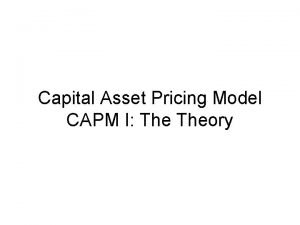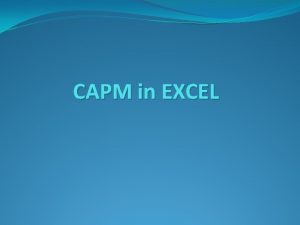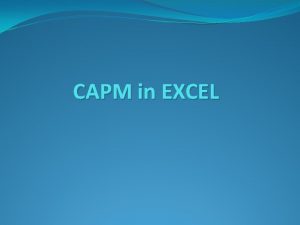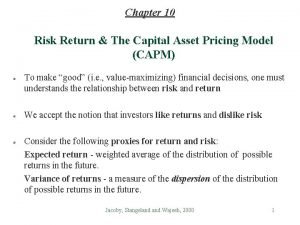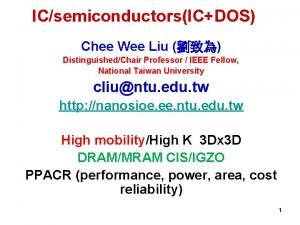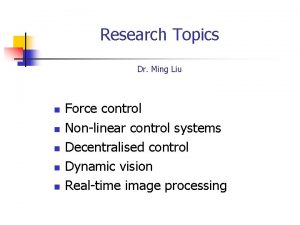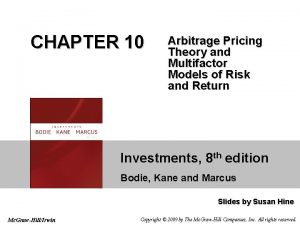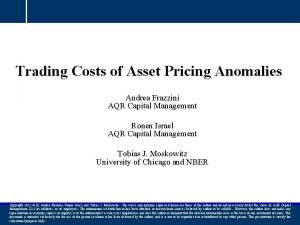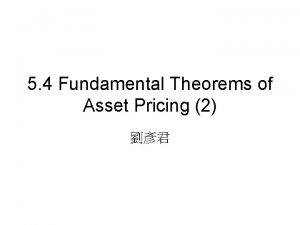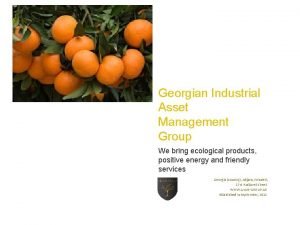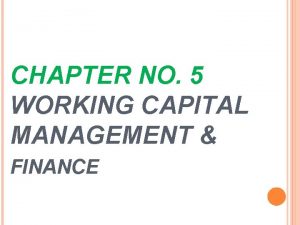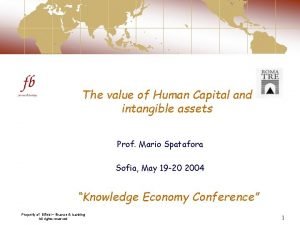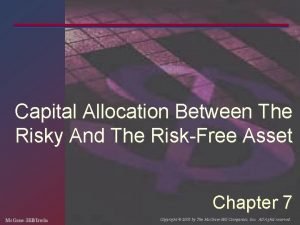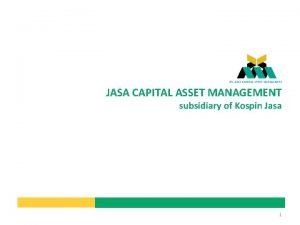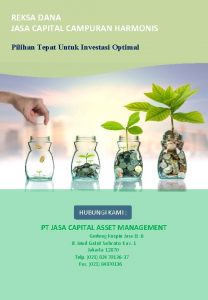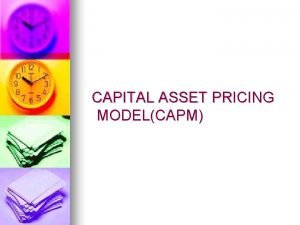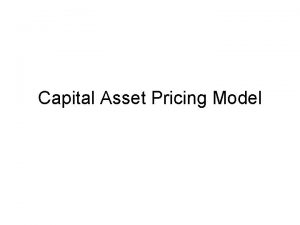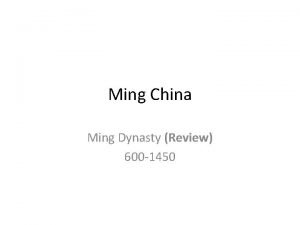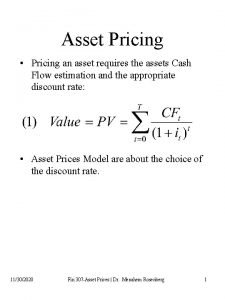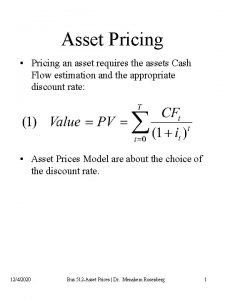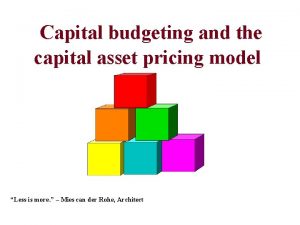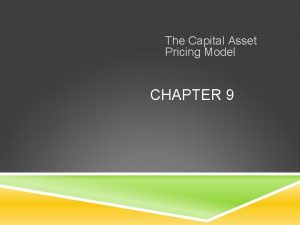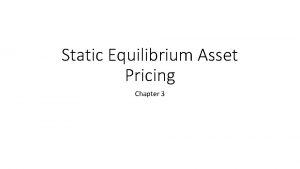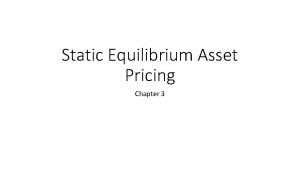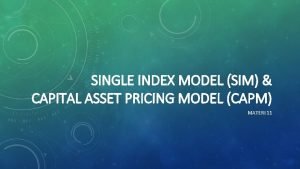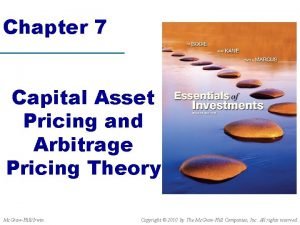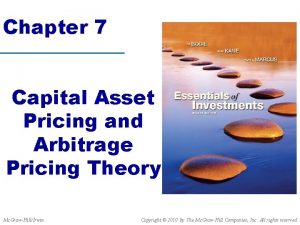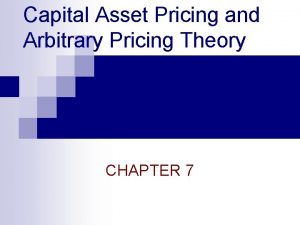The Capital Asset Pricing Model Ming Liu Industrial








![rp = w 1[α 1+β 1 rm+ε 1] + w 2[α 2+β 2 rm+ε rp = w 1[α 1+β 1 rm+ε 1] + w 2[α 2+β 2 rm+ε](https://slidetodoc.com/presentation_image/090515dff11f01983b6dfd10e475deb1/image-9.jpg)







![How to get β? • If we know Ø σ[ri] ----- standard deviation of How to get β? • If we know Ø σ[ri] ----- standard deviation of](https://slidetodoc.com/presentation_image/090515dff11f01983b6dfd10e475deb1/image-17.jpg)


- Slides: 19

The Capital Asset Pricing Model Ming Liu Industrial Engineering and Management Sciences, Northwestern University Winter 2009

Returns to financial securities Ø P 0: security price at time 0 Ø P 1: security price at time 1 Ø DIV 1: dividend at time 1 Ø r = total return = dividend yield + capital gain rate r = DIV 1/P 0+(P 1 -P 0)/P 0 (random variable) ri : the return on security i,

Ø Decompose this return ri into that part correlated with the market and that part uncorrelated with the market rm = the return on the market portfolio εi = the specific return of firm i

Systemic and Idiosyncratic Risk ri=αi+ βi rm + εi systemic risk undiversifiable risk beta risk market risk idiosyncratic risk diversifiable risk non -systematic risk

"Beta" (β) an asset market risk parameter, represents straight-line inclination degree. E is average "residual" yield, describing an average asset yield deviation from "fair" yield as shown by the central line.

ri=αi+βi rm +εi Ø The larger is βi , the more subject to market risk is this firm. Ø The larger is σ[ i] the more important is firmspecific risk.

Example Decomposing the Total Risk of a Stock Considering two stocks: A: An automobile stock with βA=1. 5, B: An oil exploration company with βB=0. 5, The variance of the market return is What is the total risk of each stock? Which has a higher expected rate of return?

Portfolio risk 1. Decompose each security return into systematic and idiosyncratic risk: ri=αi+βirm+εi 2. Form a portfolio of these securities, with portfolio weights w 1, w 2, …, wn. (sum to one) 3. The portfolio rate of return is a weighted average of the individual returns rp = w 1 r 1+w 2 r 2+…+wnrn
![rp w 1α 1β 1 rmε 1 w 2α 2β 2 rmε rp = w 1[α 1+β 1 rm+ε 1] + w 2[α 2+β 2 rm+ε](https://slidetodoc.com/presentation_image/090515dff11f01983b6dfd10e475deb1/image-9.jpg)
rp = w 1[α 1+β 1 rm+ε 1] + w 2[α 2+β 2 rm+ε 2] + … + wn[αn+βnrm+εn] Rearrange to get zero rp = α*+β*rm+ε*, where α*: = w 1α 1+w 2 α 2+…+wn α n β*: = w 1 β 1+w 2 β 2+…+wn β n ε*: = w 1 ε 1+w 2 ε 2+…+wn εn

Conclusions • β of portfolio is weighted-average β • Well diversified -> risk only from βrm term The standard deviation of a well diversified portfolio:

Construct the market portfolio • The market portfolio includes every security in the market • The weight of each security in the portfolio is proportional to its relative size in the economy • A common proxy measure for the market portfolio is the S&P 500 index. http: //www. indexarb. com/index. Component. Wts. SP 5 00. html

The Capital Asset Pricing Model Market model ri=αi+βirm+εi with αi=(1 -βi) rf ri=(1 -βi) rf+βirm+εi

ri=(1 -βi) rf+βirm+εi • Does this restricted case make sense? ØWhat does it imply for the return on a risk-free asset (βi=0)? ØWhat does it imply about the return on an asset that has the same market risk as the market portfolio (βi=1)? • The CAPM equation can be rewritten as ri-rf=βi (rm –rf )+εi

The CAPM can also be written as a linear relationship between the β of a security and its expected rate of return, E(ri )-rf=βi (E (rm )–rf ) E(ri ) : expected rate of return on the security E (rm): expected rate of return on the market portfolio rf : the risk free rate βi : the security’s beta

The Security Market Line E(ri )=rf+βi (E (rm )–rf ) E(ri )=(1 - βi)rf+βi E (rm ) E(r. A ) E(r. B ) rf βB=0. 5 βA=1. 5 βi

Example Using the Security Market Line (SML) The β of Cisco Systems is about 1. 37. The risk free rate rf=0. 07 Expected risk premium on market E (rm )–rf =0. 06 The expected rate of return on CSCO:
![How to get β If we know Ø σri standard deviation of How to get β? • If we know Ø σ[ri] ----- standard deviation of](https://slidetodoc.com/presentation_image/090515dff11f01983b6dfd10e475deb1/image-17.jpg)
How to get β? • If we know Ø σ[ri] ----- standard deviation of ri Ø σ[rm] ----- standard deviation of rm Ø ρim----- correlation between ri and rm

How to get β? • Estimate beta: ri=αi+ βi rm + εi • http: //finance. yahoo. com/

• CAPM serves as a benchmark – Against which actual returns are compared – Against which other asset pricing models are compared • Advantages: – Simplicity – Works well on average • Disadvantages: – What is the true market portfolio and risk free rate? – How do you estimate beta? – Standard deviation not a good measure of risk.
 Theorie capital asset pricing model
Theorie capital asset pricing model Formula capm excel
Formula capm excel Capital asset pricing model excel
Capital asset pricing model excel Capital market line
Capital market line Chee ming liu
Chee ming liu Liu ming chung
Liu ming chung Alex liu cecilia liu
Alex liu cecilia liu Líu líu lo lo ta ca hát say sưa
Líu líu lo lo ta ca hát say sưa Multifactor pricing models
Multifactor pricing models Erp ellipse
Erp ellipse Trading costs of asset pricing anomalies
Trading costs of asset pricing anomalies Fundamental theorem of asset pricing proof
Fundamental theorem of asset pricing proof Industrial asset management llc
Industrial asset management llc What is working capital cycle
What is working capital cycle Human capital intangible asset
Human capital intangible asset Capital allocation line
Capital allocation line Jasa capital asset management
Jasa capital asset management Jasa capital asset management
Jasa capital asset management Net working capital refers to
Net working capital refers to Difference between capital reserve and reserve capital
Difference between capital reserve and reserve capital
